Last weekend we decided to inspect our under-the-water hull. We had prepared for weeks, and found a spot where the tide would leave us high and dry for a few hours. Even better, it was right around the corner from our “normal” slip. In the middle of the night, we snuck away and motored down the long, narrow piece of water between two wharves, finally meeting a seawall, which we tied up to. I put one piling near the mast and let the others fall where they might, hanging a fender on the two that touched our hull. We set our spring lines and secured our baby with care and waited for the tide to drop. I set my alarm for four hours later. When it rang, I hopped out of my pilot berth to see what the tide was doing. Once on deck, I tied a line from our mast to the piling and cinched it tight, helping us lean into the pier. Over the next ten minutes, I stood on our cap-rail, ultimately stepping onto the land to check for movement. When finally there wasn’t any, I knew our keel was on the ground and we were beginning to stop floating. Hopefully, now I could rest.
My next alarm was set for two hours later, a.k.a. 6am. I barely caught a wink of sleep the entire night in anticipation of what might happen and what I might see. I would think of all possibilities, one being the entire hull is one blister, and many other extremes including nothing being wrong. Every time I would turn over in bed, I would think of something else. what if someone tried to steal my boat? We were right in the middle of a sketchy part of town. “How are they going to steal it, Travis? It’s not even floating!” I kept telling myself this was nonsense, I needed to sleep, and was surprised when I was awoken by my alarm clock. My blanket and sheets didn’t stand a chance as I flung them off of me to go look at the boat. Oh man, the water was mere inches from the bottom of our keel! I couldn’t act fast enough and the water took too long to boil as I made my coffee. I was in a big rush but needlessly so, as it took another half an hour for the water to come down to a level where my boots wouldn’t sink. While I sipped my coffee I screwed on a brush to my boat hook and while dunking and scrubbing I worked my way down the starboard side of my hull. To my surprise, the entire process took about half an hour. No fuss, no muss. No issues were found, not one blister, not one scratch, not even one barnacle was attached! Relief.
The scrubbing process went so quickly that I had aspirations of painting, too. Unfortunately, Maine has been under a cloud for the past who-knows-how-long, and our paint wouldn’t have dried, anyways. But it was good practice, free and we got lots of attention. The sun is supposed to make an appearance towards the end of this coming week, and we hope to be able to careen again and paint the bottom. We decided to change locations as having the solid wall on one side of you has its disadvantages. Luckily, we know of an alternate location: Peaks Island.
I’m new to the art of careening. It seems like no one does it, but I don’t know why because it’s so easy and free. If you’re in an area with at least a 7′ tide it’s definitely an option if you find the right location. Look for a tall, solid structure with at least enough water to float you at high and that dries out at low. It also helps to have a full keeled boat, or at least one that you trust not to push up into your hull.
- Close Up
- 1/2 hour before low tide
- shiny, clean prop. Text reads 6 76 15RH12, which we think means made in June 76, 15 degree pitch, right hand twist, 12″.
- Bella wonders what we’re doing down there
- view of the bow, after a good cleaning
- view from stern, after being cleaned
- bow picture, before. Note all the seaweed along the waterline.
- the bottom before cleaning, covered in muck
- about two hours after we had stopped floating
Check out more adventures of the DE32 Seabird and Travis and Sophi at http://sailingseabird.wordpress.com/

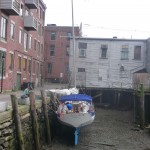
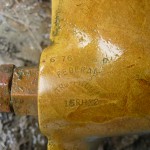

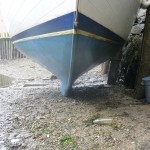
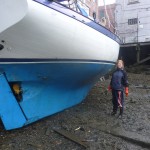


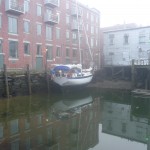

This process has always scared me to death. Just being blocked up on the hard is bad enough… and speaking of that, when we are blocked up on the hard, the yard crew always wedges a timber at an angle under the bow, presumably to keep the boat from tipping forward. Did Seabird have *any* tendency at all toward tipping forward?
bob
s/v Eolian
DE45 #11
Seattle
Bob,
I have never seen that, where they blocked the bow. I can’t imagine one of our boats tipping forward anyways. It’s a pretty long straight keel under there even with the bow sticking out past it.
In my recent haul out experience they just put some 4 or more 8×8’s under the keel and set the boat on them and then put 4 to 6 jack stands on either side of the boat to support it upright. They keel takes the full weight of the boat. I would imagine that a DE45 would be even harder to tip forward 🙂 I would bet that your yard is just following best practices or some such even when not needed as a sort of standard procedure. I’ve been trying to picture any full keel boat I know of that would tilt forward if not blocked and can’t bring a single example to mind.
Granted that I can’t claim universal knowledge about all boats. Anyone else have an opinion on this?
Hi Bob,
Seabird was steady as a rock once she was careened. The thing we didn’t mention in the blog was that it was not the best-protected place to carreen, so there were little waves lifting us off the sand and putting us back down for about 15 minutes before she settled down completely — that was annoying but the bottom was soft so it didn’t do any damage.
We careened our first boat, a Catalina 27′, and she was much less stable. We did not remain aboard at all when she was on the hard. With Seabird we just tried to stay off the very tip of the bow, but she felt quite secure. With Neptune (the catalina) she did tip forward a bit, but then the lines we had tied caught her and she just sat sort of funny til the tide came in again. I can’t imagine that at DE would tip forward, the weight of everything in the keel will keep her down! If you’re still worried about it I might move your anchors and chain to the stern just for safety’s sake, and try to find a place to careen where there isn’t much wave action so that once she sits, she’s sitting solidly.
Best of luck!
Sophi
s/v Seabird, DE 32
Portland, Maine
Oops, I was wrong — at this location there were no waves at all and Seabird rested gently onto the bottom (which was a little pebbly). It was on Peaks Island a week later, when we painted, that there were some waves causing the careening to take a few minutes longer than it did in the post above.
Sophi
s/v Seabird,DE 32
Portland,Maine
Thanks Sophi –
That is reassuring. But the process still scares me to death. Eolian is heavy… just having a little lean toward the dock would still mean substantial pressure there, but with only a little lean, it would seem to be precarious…
bob
s/v Eolian
DE45 #11
Seattle
I would think as long as you didn’t fall over that one of our boats could easily handle being careened on their sides much less just leaning into some pilings. That would be a good question. has anyone ever actually fully careened their DE on it’s side?
Scott — it probably could “handle” it, but why would you want to do that? I know that even in yards when boats are on stands that the weight of the keel is meant to rest on the ground, the stands are just for stability. If you use a fixed seawall or pilings for your stability and rest the weight on the keel, as we did, it shouldn’t be a risky thing for your boat. If you rest it on your side, I would think that the rising tide would wash down your companionway hatch before the boat floated again?? I have never heard of anyone doing it this way, I’d be curious if anyone else has..
Yep thats me 🙂 curious to see if anyone has ever done it and what the results were.